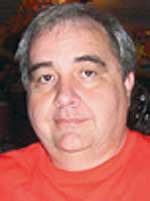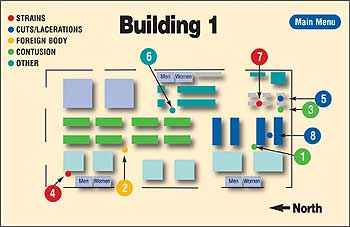Search News
For the Media
For media inquiries, call CWA Communications at 202-434-1168 or email comms@cwa-union.org. To read about CWA Members, Leadership or Industries, visit our About page.
Hazard Mapping Reduces Injuries at GE
Workplace and hazard mapping is a tool that a number of unions are now using to identify unsafe job areas by literally producing a floor map of the worksite.
Now, IUE-CWA Local 81201 is working with the company in developing a more high-tech approach to the process at General Electric's Aviation plant in Lynn, Mass. Together, they have put the map into a computerized database where safety and health representatives can access injury data for a year or more, across the plant.
 "This system has been invaluable in allowing our local and management to identify trends. Having such comprehensive data at our fingertips allows us to develop a workable strategy for reducing injuries in the next year," said Don Doucette, one of the local's health and safety representatives.
"This system has been invaluable in allowing our local and management to identify trends. Having such comprehensive data at our fingertips allows us to develop a workable strategy for reducing injuries in the next year," said Don Doucette, one of the local's health and safety representatives.
The workplace mapping system, begun in 2006, is in place in many of the buildings throughout the complex where more than 2,000 IUE-CWA members work.
The plant that once produced lights and electric motors beginning in the late 1880s is one of the nation's leading manufacturing operations, turning out jet engines for both commercial aircraft (Boeing and Airbus) and the Department of Defense (fighters and helicopters).
The massive machinery — huge metal lathes, milling equipment and grinders — means increased workplace hazards. IUE-CWA member Stephen Gauthier stands at a 40-foot long machine to grind an integrated gear shaft that weighs 23,000 pounds. "You never forget the scale of what we work around each day," he said. Sixty-ton auxiliary cranes used to hoist heavy aircraft engines and components hover high above the plant floor.
Before the joint labor-management safety program got fully underway in 1991, the plant had a very high OSHA injury rating of 25, meaning that 25 out of 100 workers experienced serious injuries. The high injury rate also caused workers' compensation costs to skyrocket.
The workplace and hazard mapping program has helped bring the plant's OSHA injury rate to below 3, a rate far below the industry average.
 In most workplaces, injury documentation in hazard mapping systems is kept in numerous, separate databases. That makes it extremely difficult to conduct an overall plant safety assessment without a time consuming analysis to determine where most of the injuries occur, what areas or workstations experience the most injuries and what is the most common injury at each workstation.
In most workplaces, injury documentation in hazard mapping systems is kept in numerous, separate databases. That makes it extremely difficult to conduct an overall plant safety assessment without a time consuming analysis to determine where most of the injuries occur, what areas or workstations experience the most injuries and what is the most common injury at each workstation.
The workplace hazard map brings together all of the data in one electronic database that enables IUE-CWA safety officers to access information about all job injuries, including where and when they happened and whether trends are occurring.
On a floor map of each work area, the injury locations are marked by a circle, color-coded and numbered according to the kind of injury and number sustained, i.e., strain, cut/laceration or contusion. Each circle is hyperlinked to an injury database that provides additional information about each injury.
"We view it as a shared tool that we use together," said Doucette. "Since it's been put in place, management has been much more able and receptive to addressing our issues."
The system has been so successful that GE has shared the system with most of its worksites around the country.